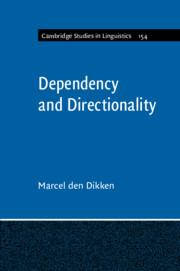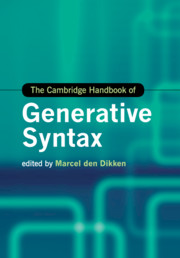50 results
Copyright page
-
- Book:
- Dependency and Directionality
- Published online:
- 19 June 2018
- Print publication:
- 05 July 2018, pp vi-vi
-
- Chapter
- Export citation
5 - The Trouble with Subjects
-
- Book:
- Dependency and Directionality
- Published online:
- 19 June 2018
- Print publication:
- 05 July 2018, pp 254-358
-
- Chapter
- Export citation
Additional material
-
- Book:
- Dependency and Directionality
- Published online:
- 19 June 2018
- Print publication:
- 05 July 2018, pp xiv-xiv
-
- Chapter
- Export citation
Abstracts and Keywords
-
- Book:
- Dependency and Directionality
- Published online:
- 19 June 2018
- Print publication:
- 05 July 2018, pp 361-368
-
- Chapter
- Export citation
6 - Conclusion
-
- Book:
- Dependency and Directionality
- Published online:
- 19 June 2018
- Print publication:
- 05 July 2018, pp 359-360
-
- Chapter
- Export citation
Index
-
- Book:
- Dependency and Directionality
- Published online:
- 19 June 2018
- Print publication:
- 05 July 2018, pp 384-388
-
- Chapter
- Export citation
2 - The Directionality of Structure Building
-
- Book:
- Dependency and Directionality
- Published online:
- 19 June 2018
- Print publication:
- 05 July 2018, pp 14-102
-
- Chapter
- Export citation
Acknowledgements
-
- Book:
- Dependency and Directionality
- Published online:
- 19 June 2018
- Print publication:
- 05 July 2018, pp xv-xvi
-
- Chapter
- Export citation
Dedication
-
- Book:
- Dependency and Directionality
- Published online:
- 19 June 2018
- Print publication:
- 05 July 2018, pp vii-viii
-
- Chapter
- Export citation
Contents
-
- Book:
- Dependency and Directionality
- Published online:
- 19 June 2018
- Print publication:
- 05 July 2018, pp ix-xiii
-
- Chapter
- Export citation
3 - Find the Gap
-
- Book:
- Dependency and Directionality
- Published online:
- 19 June 2018
- Print publication:
- 05 July 2018, pp 103-193
-
- Chapter
- Export citation
References
-
- Book:
- Dependency and Directionality
- Published online:
- 19 June 2018
- Print publication:
- 05 July 2018, pp 369-383
-
- Chapter
- Export citation
1 - Introduction
-
- Book:
- Dependency and Directionality
- Published online:
- 19 June 2018
- Print publication:
- 05 July 2018, pp 1-13
-
- Chapter
- Export citation
4 - A Syntactic Typology of Long Ā-dependencies
-
- Book:
- Dependency and Directionality
- Published online:
- 19 June 2018
- Print publication:
- 05 July 2018, pp 194-253
-
- Chapter
- Export citation

Dependency and Directionality
-
- Published online:
- 19 June 2018
- Print publication:
- 05 July 2018
Bettelou Los, Corrien Blom, Geert Booij, Marion Elenbaas & Ans van Kemenade, Morphosyntactic change: A comparative study of particles and prefixes (Cambridge Studies in Linguistics 134). Cambridge: Cambridge University Press, 2012. Pp. xiii+251.
-
- Journal:
- Journal of Linguistics / Volume 49 / Issue 3 / November 2013
- Published online by Cambridge University Press:
- 17 October 2013, pp. 703-709
- Print publication:
- November 2013
-
- Article
- Export citation
Part I - Background
-
- Book:
- The Cambridge Handbook of Generative Syntax
- Published online:
- 05 August 2013
- Print publication:
- 25 July 2013, pp 1-92
-
- Chapter
- Export citation

The Cambridge Handbook of Generative Syntax
-
- Published online:
- 05 August 2013
- Print publication:
- 25 July 2013
Contents
-
- Book:
- The Cambridge Handbook of Generative Syntax
- Published online:
- 05 August 2013
- Print publication:
- 25 July 2013, pp v-vi
-
- Chapter
- Export citation
References
-
- Book:
- The Cambridge Handbook of Generative Syntax
- Published online:
- 05 August 2013
- Print publication:
- 25 July 2013, pp 1006-1139
-
- Chapter
- Export citation



